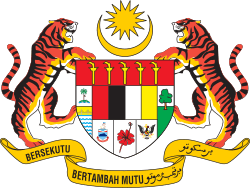Tourism in Malaysia
Malaysia was once ranked 9th in the world for tourist arrivals.[1] The Travel and Tourism Competitiveness Report 2017 ranks Malaysia 25th out of 141 countries overall.
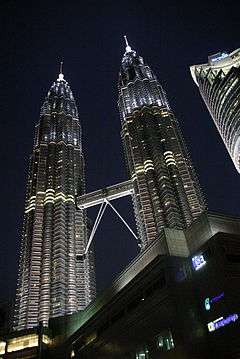
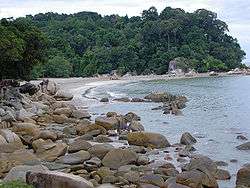
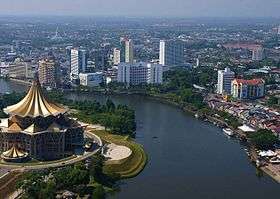
In an effort to diversify the economy and make Malaysia's economy less dependent on exports, the government pushed to increase tourism in Malaysia. As a result, tourism has become Malaysia's third largest source of foreign exchange income,[2] and accounted for 7% of Malaysia's economy as of 2005.[3]
The government agency in charge of promoting tourism in Malaysia is Tourism Malaysia or the Malaysia Tourism Promotion Board (MTPB). On 20 May 1987, the Ministry of Culture, Arts and Tourism (MOCAT) was established and TDC moved to this new ministry. TDC existed from 1972 to 1992, when it became the Malaysia Tourism Promotion Board (MTPB), through the Malaysia Tourism Promotion Board Act, 1992.
In 1999, Malaysia launched a worldwide marketing campaign called "Malaysia, Truly Asia" which was largely successful and brought in over 7.4 million tourists.[4] The extra revenue generated by tourism helped the country's economy during the economic crisis of 2008.[5]
Types of tourism
Medical tourism
Medical tourism is popular in Malaysia, with the Malaysia Healthcare Travel Council reporting an arrival of 641,000 foreign patients in 2011, 728,800 in 2012, 881,000 in 2013 and 882,000 in 2014.[6] Malaysia Healthcare Travel Council, a government agency with the aim of promoting medical tourism, was launched in 2009 as an initiative by the Ministry of Health.[7]
Tourist arrivals
Tourist arrivals
In 2016, Malaysia recorded 26,757,392 tourist arrivals, a growth of 4.0% compared to 25,721,251 in 2015.
| Rank | Country | Visitors (2019)[8] | Visitors (2018)[9] | Visitors (2017)[10] | Visitors (2016)[11] | Visitors (2015)[12] | Visitors (2014)[13] | Visitors (2013)[14] |
|---|---|---|---|---|---|---|---|---|
| 1 | 10,163,882 | 10,615,986 | 12,441,713 | 13,272,961 | 12,930,754 | 13,932,967 | 13,178,774 | |
| 2 | 3,623,277 | 3,277,689 | 2,796,570 | 3,049,964 | 2,788,033 | 2,827,533 | 2,548,021 | |
| 3 | 3,114,257 | 2,944,133 | 2,281,666 | 2,124,942 | 1,677,163 | 1,613,355 | 1,791,423 | |
| 4 | 1,884,306 | 1,914,692 | 1,836,522 | 1,780,800 | 1,343,569 | 1,299,298 | 1,156,452 | |
| 5 | 1,216,123 | 1,382,031 | 1,660,506 | 1,391,016 | 1,133,555 | 1,213,110 | 1,238,471 | |
| 6 | 735,309 | 600,311 | 552,739 | 638,578 | 722,141 | 770,108 | 650,989 | |
| 7 | 673,065 | 616,783 | 484,528 | 444,439 | 421,161 | 385,769 | 274,622 | |
| 8 | 424,694 | 394,540 | 392,777 | 413,768 | 483,569 | 553,106 | 513,076 | |
| 9 | 421,908 | 396,062 | 370,559 | 417,446 | 554,917 | 618,538 | 557,147 | |
| 10 | 400,346 | 375,578 | 248,927 | 216,877 | 229,626 | 285,716 | 235,700 | |
| 11 | 382,916 | 383,922 | 332,927 | 300,861 | 283,224 | 274,665 | 286,266 | |
| 12 | 368,271 | 351,500 | 351,232 | 377,727 | 486,948 | 571,328 | 526,342 | |
| 13 | 346,485 | 361,335 | 358,818 | 400,269 | 401,019 | 445,789 | 413,472 | |
| 14 | 269,928 | 253,384 | 198,203 | 217,075 | 237,768 | 262,106 | 246,936 | |
| 15 | 179,000 | 150,054 | 111,836 | 114,607 | 147,152 | 204,418 | 134,663 | |
| Grand total | 26,100,784 | 25,832,354 | 25,948,459 | 26,757,392 | 25,721,251 | 27,437,315 | 25,715,460 |
Destinations and attractions
- Alor Star – capital of Kedah, the state of the paddy fields
- George Town – the capital city of Penang, one of the country's UNESCO World Heritage Sites since 7 July 2008.
- Ipoh – capital of Perak, famous for its Chinese food, tin mines and limestone mountains and caves
- Johor Bahru – capital of Johor, and gateway to Singapore
- Kangar – capital of Perlis, and gateway to Thailand
- Kota Kinabalu – capital and the gate way to Sabah which is Mount Kinabalu
- Kota Bharu – capital of Kelantan, and gateway to Thailand
- Kuala Terengganu – capital of Terengganu, famous for the turtles and beaches
- Kuantan – capital of Pahang, noted for its many beaches
- Kuching – capital of Sarawak, the Cat City of Malaysia
- Malacca City – a historical city in Malaysia. This is the other cultural World Heritage Site in Malaysia since 7 July 2008.
- Marina Island - first man-made island situated between Lumut and Pangkor
- Miri – the resort city of Sarawak is the gateway to the UNESCO World Heritage Site of the Mulu caves and numerous national parks like Niah caves, Lambir Hills National Park and Loagan Bunut National Park. Noted for its pristine coral reefs and ecotourism attractions too.
- Seremban – the capital of Negeri Sembilan, and the nearest cities to Port Dickson
- Putrajaya – the administrative centre of Malaysia
- Petaling Jaya – a satellite city located in the state of Selangor, and is in the proximity of Kuala Lumpur. It has the most commercial complexes in Malaysia.
Beside the main cities, there other town and places in Malaysia offer some special tourist attraction. Such as in Taiping, Perak for their landscape and local attraction. Teluk Intan for their Leaning tower. Genting Highlands, Cameron Highlands and Bukit Tinggi in Pahang for a cool climate. Muar in Johor is famous for its food. Miri is the official tourism-city and resort city of Sarawak and Sibu in Sarawak is famous for its landscape and parks.
Islands and beaches
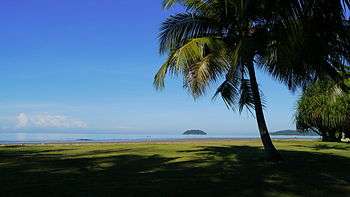
Malaysia has several tropical islands. Some of the islands in Malaysia are:
- Labuan
- Langkawi
- Pangkor
- Marina Island
- Penang Island, the western halve of Penang, which also includes George Town
- Redang Island
- Tenggol Island
- Tunku Abdul Rahman National Park
- Perhentian Islands
- Kapas Island
- Lang Tengah Island
- Rantau Abang Beach
- Mabul
- Tioman Island
- Sipadan
- Rawa Island
- Pulau Ketam
National parks and nature reserves
- Kubah National Park, (Sarawak)
- Bako National Park, Sarawak – famed for its wildlife, especially Bornean bearded pigs and proboscis monkeys
- Batang Ai National Park, Sarawak
- Gunung Mulu National Park, Sarawak
- Gunung Gading National Park, Sarawak
- Lambir Hills National Park, Sarawak
- Niah Caves National Park, Sarawak
- Loagan Bunut National Park, Sarawak
- Kinabalu National Park, Sabah – home of 4100 metre peak Mount Kinabalu
- Taman Negara National Park – the world's oldest rainforest, spanning Kelantan, Pahang and Terengganu
- Endau Rompin National Park, Johor
- Taman Eko Rimba, Kuala Lumpur - the nature reserve in the middle of Kuala Lumpur. The nature reserve is located near Kuala Lumpur Tower.
Other places of interest
- A' Famosa Resort, Malacca
- Alor street food night market, KL
- Aquaria KLCC, at KLCC tower, KL
- Bakelalan, Sarawak
- Bario , Sarawak
- Batu Caves, Selangor
- Batu Ferringhi, George Town
- Berjaya Hills Resort. French-themed village
- Berjaya Times Square KL, KL
- Bukit Bintangwalk, KL
- Cruise Tasik Putrajaya (CTP) Lake cruises, boat rides, Putrajaya
- Cameron Highlands, Pahang
- Central Market, KL
- Cheng Hoon Teng Temple (青云亭), Malacca
- Chin Swee Caves Temple, Pahang
- Crystal Mosque, Kuala Terengganu
- Dhammikarama Burmese Temple, Penang
- Dong Zen Temple (佛光山東禪寺), Selangor
- Eye on Malaysia, Malacca
- Forest Research Institute Malaysia (FRIM)
- Fort Cornwallis, George Town
- Fraser's Hill
- Genting Highlands, Pahang
- Gurney Drive, George Town
- Iskandar waterfall Kota Tinggiwaterfalls
- Islamic Arts Museum, KL
- Kampung Baru, KL
- Kampung Setar
- Kek Lok Si (极乐寺), George Town
- Kuala Gandah Elephant Sanctuary[15][16]
- Kuala Lumpur Bird Park, KL
- Kuala Lumpur Butterfly Park, KL
- Kuala Lumpur Hop-On Hop-Off, double-decker city tour bus, KL
- Kuala Lumpur Look Out Point, KL
- Kuala Lumpur Tower, Menara Kuala Lumpur, KL
- Kuala Lumpur Craft Complex, KL
- Long Pasia, Sipitang, Sabah
- Malaysia Tourism Centre (MaTiC), KL
- Masjid Negara
- Melaka Gateway, Malacca
- Merdeka Square
- Mines Resort City, KL
- Monorail train at KL
- Movie Animation Park Studios (MAPS), Perak
- Muzium Negara, KL
- National Monument Tugu Negara, KL
- Penang Hill, Penang
- Perdana Botanical Garden, KL
- Petronas Twin Towers (KLCC), KL
- Poh San Teng Temple (宝山亭), Malacca
- Rumah Penghulu Abu Seman, KL
- Snake Temple, Penang
- Sri Mahamariamman Temple, KL
- Stadium Bukit Jalil
- Stadium Merdeka
- Stadium Negara
- Sultan Abdul Samad Building
- Sultan Salahuddin Abdul Aziz Mosque, Shah Alam, Selangor
- Sunway Lagoon, Petaling Jaya
- Thean Hou Temple, KL
- Underwater world, Langkawi
- Wat Chetawan, Petaling Jaya
- Wat Phothivihan, Kelantan
- National Zoo of Malaysia (Zoo Negara), KL
References
- http://travel-to-malaysia.com/malaysia-is-ninth-most-visited-in-the-world-in-unwto-list/
- Munan, Heidi. Malaysia. New York: Benchmark Books, 2002. pp. 28.
- "M'sia is ninth most visited in the world in UNWTO list". The Star. 7 February 2012. Archived from the original on 18 February 2012. Retrieved 17 February 2008.
- Munan, Heidi. Malaysia. New York: Benchmark Books, 2002. pp. 29.
- Warshaw, Steven, and A. J. Tudisco. Southeast Asia Emerges; a Concise History of Southeast Asia from Its Origin to the Present. [Berkeley, Calif.]: Diablo, 1975. Print. pp. 77.
- "Statistics". Malaysia Healthcare Travel Council. Archived from the original on 3 August 2015. Retrieved 16 August 2015.
- "Who we are". Malaysia Healthcare Travel Council. Retrieved 16 August 2015.
- "Top 45 Tourist Arrivals (2019)" (PDF). Retrieved 25 March 2020.
- "Top 45 Tourist Arrivals (2018)" (PDF). Retrieved 21 February 2019.
- "Top 45 Tourist Arrivals (2017)" (PDF). Retrieved 18 April 2018.
- "Top 45 Tourist Arrivals (2016)" (PDF). Retrieved 4 March 2018.
- "Top 45 Tourist Arrivals (2015)" (PDF). Retrieved 4 March 2018.
- "Top 45 Tourist Arrivals (2014)" (PDF). Retrieved 4 March 2018.
- "Top 45 Tourist Arrivals (2013)" (PDF). Retrieved 4 March 2018.
- Kuala Gandah Elephant Sanctuary (Temerloh) Archived 18 June 2011 at the Wayback Machine, Tourism Pahang.
- Kuala Gandah Elephant Sanctuary, Endemic Guides.
External links
| Wikivoyage has a travel guide for Malaysia. |
